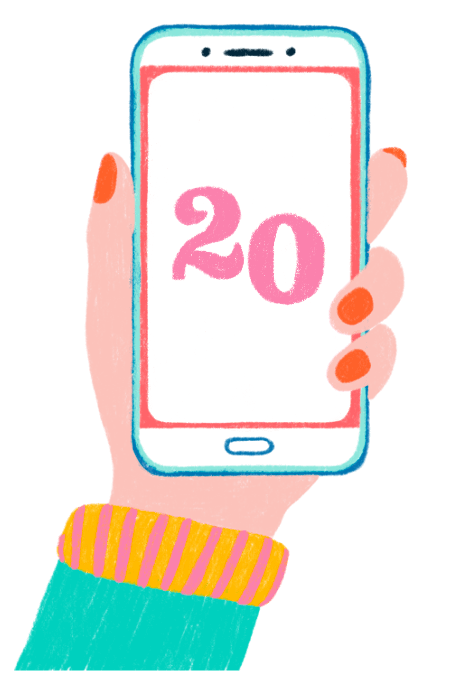Running an Etsy shop is quite the journey, with each of us pouring our heart into our creations. I’ve been exploring ways to help our work connect better with the right people, visitors who will end up as happy buyers. In this free guide, you’ll find a handful of insights and edits I’ve discovered throughout my 11 years as a full-time Etsy seller that might just help your listings resonate more and get your beautiful creative work the visibility it deserves.

1. Put a dealbreaker in the first 20 characters of your listing title
Make the first 20 to 40 characters of your title something people could make their purchase decision on or could otherwise get confused by. Think of things like: is it a digital file or a framed print, is that chair handmade or vintage, is it a large pillow or a small one?
Why is this necessary, and why such a small part?
Because in Etsy’s search results and on most mobile devices, the first 20 to 40 characters of your listing title is the first and only thing people see when they shop on Etsy.
A buyer sees your listing and decides to click on it based on two factors: the picture they see, and those 20+ characters underneath it (actual count depends on device used). If your item doesn’t match what they were expecting to see, for example when you sell a DIY digital print when in fact they were looking for a framed print, they quickly see they’re in the wrong place and go back to the search results. This leaves you with a view that didn’t convert into a sale. Does it matter? Yes, this matters tremendously, because views that don’t result in actual sales, lower your conversion rate.
The amount of people who see your work versus the amount of people who buy, called your conversion rate, is a huge factor for Etsy’s algorithm to determine whether your work is relevant enough to show to people and rank higher. Etsy’s job is to curate and make as many sales as possible, and it prefers to do this with listings that get actual sales from views, because what better way to learn if something is worth looking at than actually seeing sales coming from it?
So if you feel some of your listings are underperforming, check the first part of your title. Are there any words you can add to it that make it clear from the start what it is they’ll be getting? Think of size, material, digital or physical, new or vintage, ready made or made to order.
For example: let someone who’s looking for a pillow cover know that yours is a big one by adding ‘large’ or ‘XL’ to the front of your title. Tell shoppers looking for items made with organic cotton right there in the first 20-40 characters that that’s what they’re getting. Let people know that the photo collage they’re looking at is a DIY template that needs editing in Canva, not something custom made by you.
These are all dealbreakers that should be made very clear to Etsy shoppers, even before people click on your listing in search results.

2. Align your main image with the shown price variation
When buyers scroll through Etsy, the first thing that catches their eye is the image of your product. It’s essential that this image matches the price they see. Misalignment here can cause frustration and distrust, often referred to as ‘bait and switch’ pricing (you can see this happening a lot on AliExpress and Temu, for example). This happens when the customer is drawn in by a certain image, assuming the price listed is for the item they’re viewing, only to discover that the price corresponds to a different, often smaller or simpler variation.
This is not just about avoiding customer frustration. It’s also about ensuring you don’t damage your conversion rate. When potential buyers click on a listing only to leave because the price doesn’t match the expected product, it affects your shop’s performance metrics on Etsy. And remember, conversion rate isn’t just a number; it’s a reflection of customer satisfaction and directly influences your search ranking.
How do you avoid this? If you’re selling multiple sizes or variations, consider featuring the image of the smallest or most basic option – the one that matches the starting price. Utilize mockups to accurately represent scale and detail, giving customers a true-to-life preview of what they’re considering.
Take a framed artwork as an example: if you’re displaying the large $158 option but the starting price is $87 for a smaller size, customers may feel misled. It’s better to show the $87 option upfront and let customers explore other sizes and prices as add-ons. This transparency not only improves customer experience but could also give you an edge over competitors, leading to better conversion rates and potentially a higher search rank due to honest pricing practices.

3. Use long tail keywords with little competition
Selling on Etsy can feel like setting up shop in a bustling marketplace. To be heard above the noise, it’s essential to get specific, and this is where “long-tail keywords” come into play. These are the longer, more specific phrases that shoppers are likely to use when they are closer to a point of purchase or when they’re searching for a niche item.
Why long-tail keywords? Because specificity reduces competition. Instead of vying for attention using a generic term like “t-shirt” where you’re one in a million, a long-tail keyword like “women’s organic cotton v-neck t-shirt” narrows down the search results and leads the right customers straight to your doorstep.
Consider this: a shopper looking for a gift is more likely to search for “handmade blue ceramic coffee mug” than just “mug”. By optimizing for long-tail keywords, you position your products as the answer to their specific needs. It’s not about getting a sea of eyes on your work; it’s about getting the right eyes.
Craft your tags thoughtfully within Etsy’s character limit, and don’t be afraid to get detailed. Think about the unique qualities of your item – its material, purpose, who it’s for, or even the story behind it. Use these details to build your keywords.
Remember, every word in your long-tail keyword is a chance to connect with a customer who is looking for exactly what you offer. By using these tailored keywords, you’re not just improving your search presence; you’re building a bridge to the buyers who are searching for the unique treasures that you create.

4. Be yourself in product descriptions
Your product descriptions are more than just a list of features; they are the narrative that connects your creation to the customer’s life. It’s where you get to tell the story of how your product will enhance their world. So, instead of simply stating what the item is, focus on the experience it offers. How will it make their life brighter, easier, or more joyful?
For instance, if you’re selling handcrafted candles, don’t just talk about the scent. Describe the warm, inviting ambiance it will create in their home, transforming an ordinary evening into a cozy retreat. This personal touch resonates much deeper than any generic description ever could.
And remember, the charm is in the authenticity. Write like you speak. This isn’t the place for corporate jargon or robotic language; it’s a space to be human. Think of it as writing a letter to a friend. You’re not just selling them a product; you’re inviting them into a piece of your world, offering them something that has been made with care and will be cherished in their daily life.
Let your unique voice shine through. Are your products playful? Sophisticated? Whimsical? Let that personality be part of your description. This not only differentiates you from the masses but also builds a connection with customers who share your ethos and appreciate the love poured into your work.
Ultimately, your product descriptions should mirror the intimate experience of walking into a small local shop where the owner greets you by name and tells you the stories behind each item. That’s the human touch that turns a browsing shopper into a loyal customer.

5. Clearly written cancellation & return policy
Trust is the foundation of any successful Etsy shop, and one of the keystones of trust is transparency, particularly when it comes to your cancellation and return policy. A well-defined policy does more than just inform; it reassures your customers that they can shop with confidence.
For sellers doing business with the EU and the UK, it’s not only about building trust but also complying with legal requirements. A 30-day return policy is mandatory, so make sure this is clearly stated. However, it’s not enough to just mention the timeframe; you should explain the process. Detail what items can be returned, the condition they must be in, and how a customer should initiate a return. Don’t forget to cover cancellations as well – let your customers know how they can cancel, and the time frame they have to do so after placing an order.
But clarity doesn’t have to come at the cost of warmth. Write your policy in a way that feels personal and considerate. After all, a policy written with empathy can turn a potentially stressful process into a positive touchpoint with your customer. It’s not just about laying out terms; it’s about extending a hand of understanding and assistance.
By ensuring that your policy is both legally compliant and presented with a human touch, you set a tone of professionalism and care. This not only supports a smooth shopping experience but also fosters long-term customer relationships. Remember, your policy is more than fine print; it’s a promise of quality and support that you offer to every customer who chooses to shop with you.

6. Picture of you (or your hands) creating your work
I guess what they say is true: a picture is worth a thousand words. This is especially true on Etsy. Put in a photo of your hands at work, and you instantly tell buyers, “Hey, this is the real deal, made with care by these two hands.”
This way, you take away any doubts your visitors could have about you potentially being a reseller, not an actual maker. Sadly enough, Etsy is being flooded with these kind of shops nowadays. Luckily, buyers are still looking for handmade goods, but they are very careful about it not to buy something that looks genuine, but actually is not.
So they want to see the story, the person behind the product. And nothing says ‘handmade’ like a snapshot of the creation process. It cuts through their worries about reselling. It’s like saying, “Look, this is me making it,” without having to spell it out.
Take a sec to think about it. When you shop, don’t you just love knowing who made what you’re buying? It’s a touch of personal connection in a world that’s often way too impersonal. So snap a pic next time you’re in the middle of making something. It doesn’t have to be perfect either. Your buyers will love seeing where and how their new favorite thing is coming to life.
Shops that prove they’re selling genuine handmade items can really stand out. That trust you build is golden, and very necessary. It could mean the difference between someone just browsing and actually adding to their cart.


